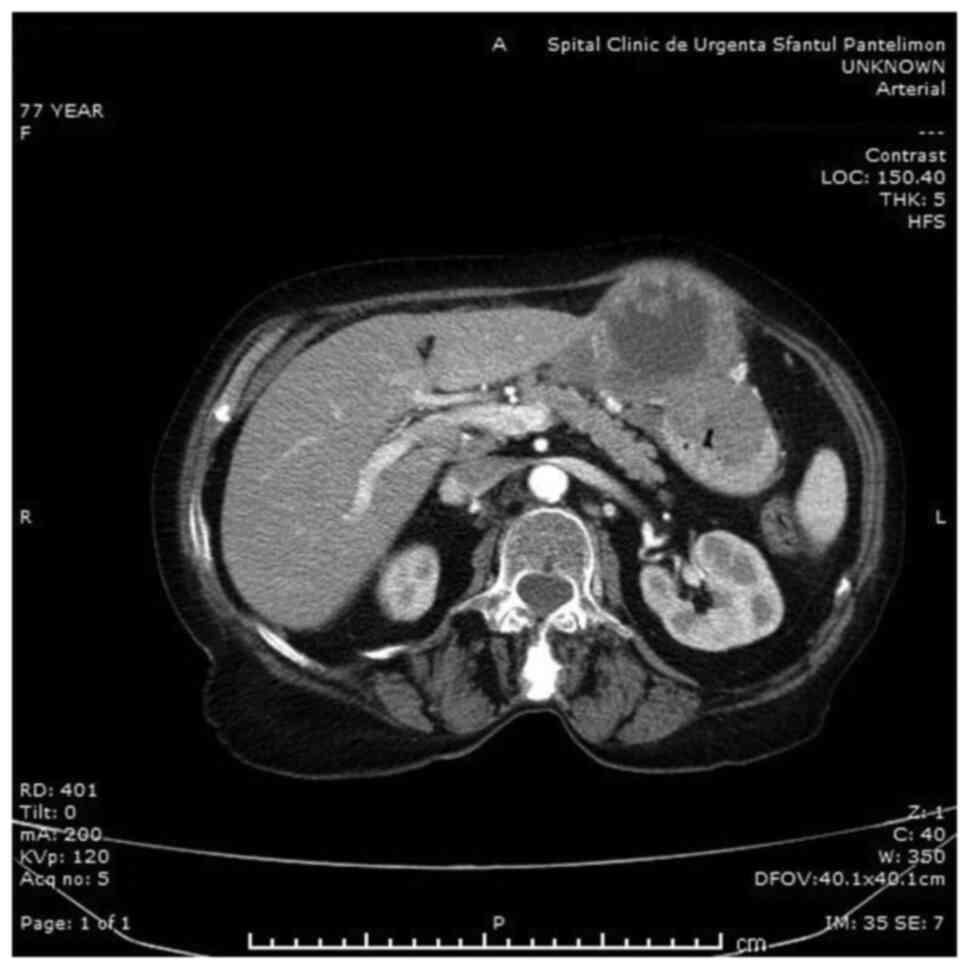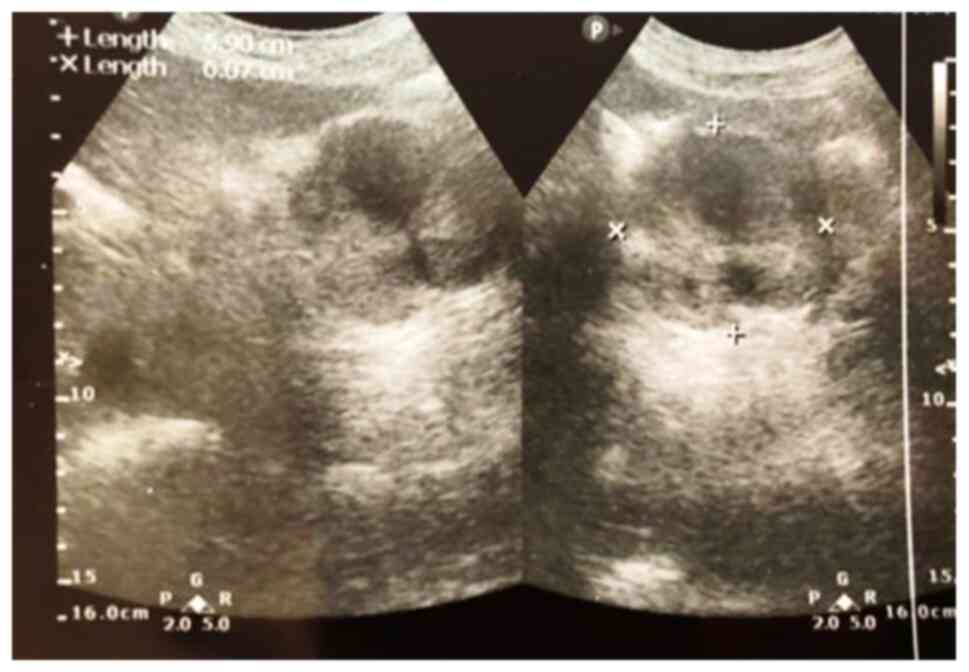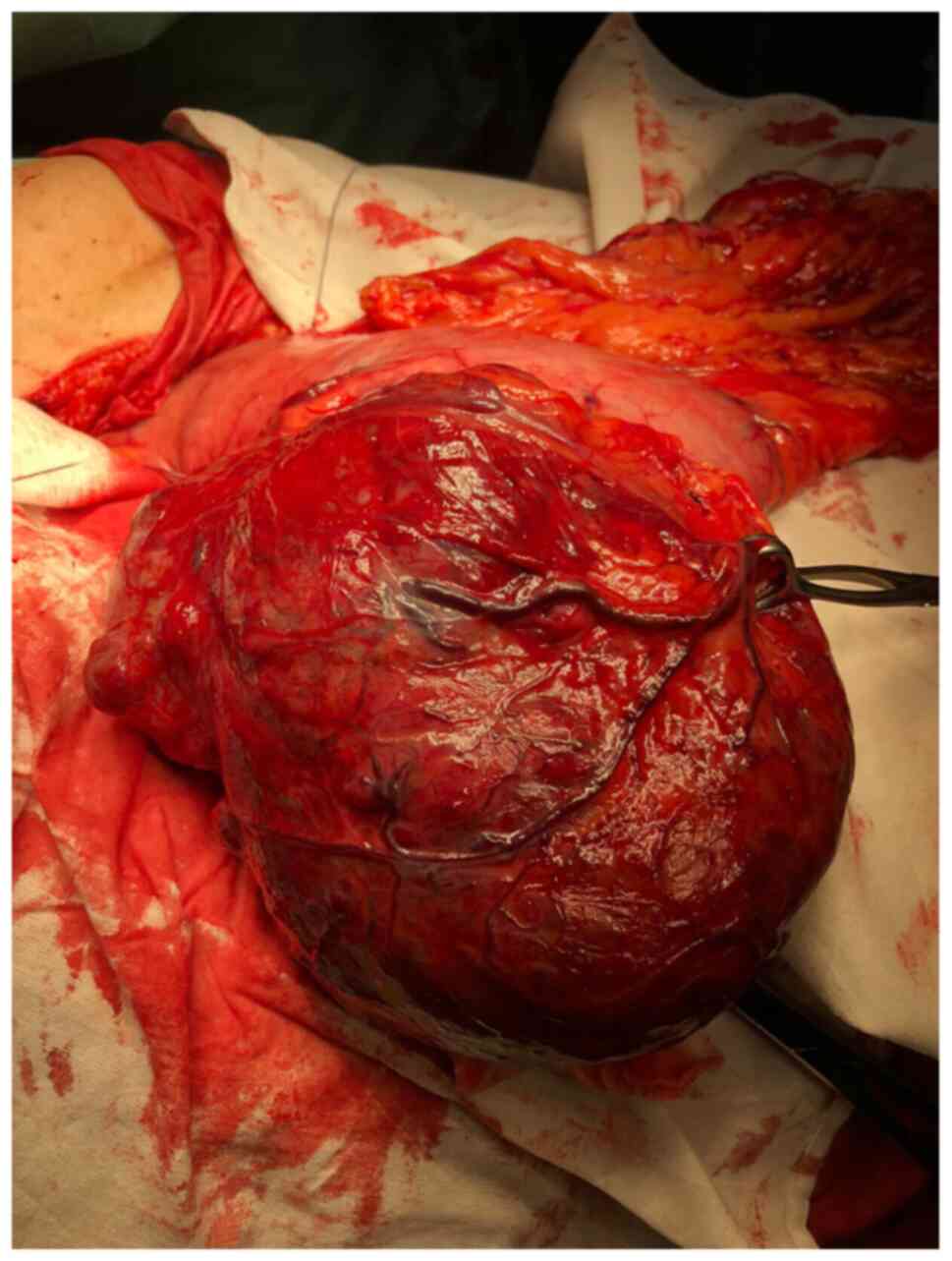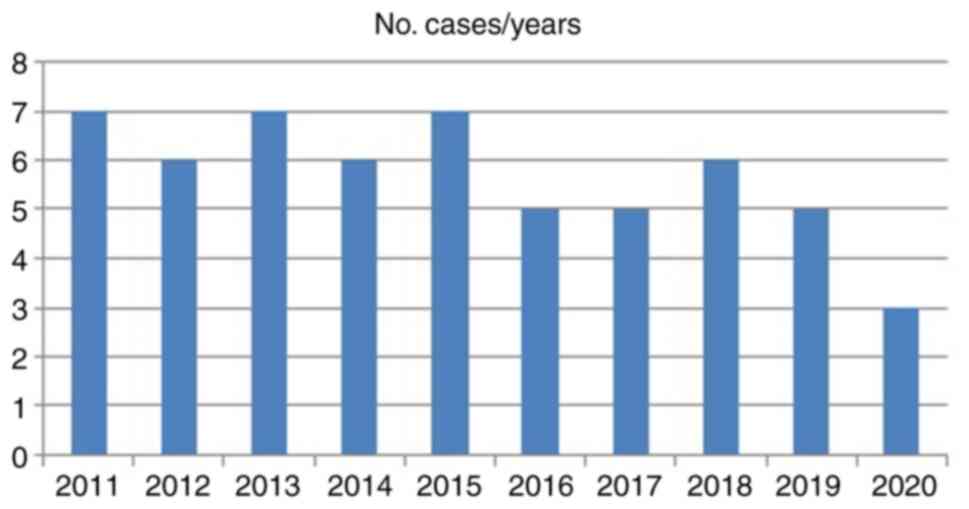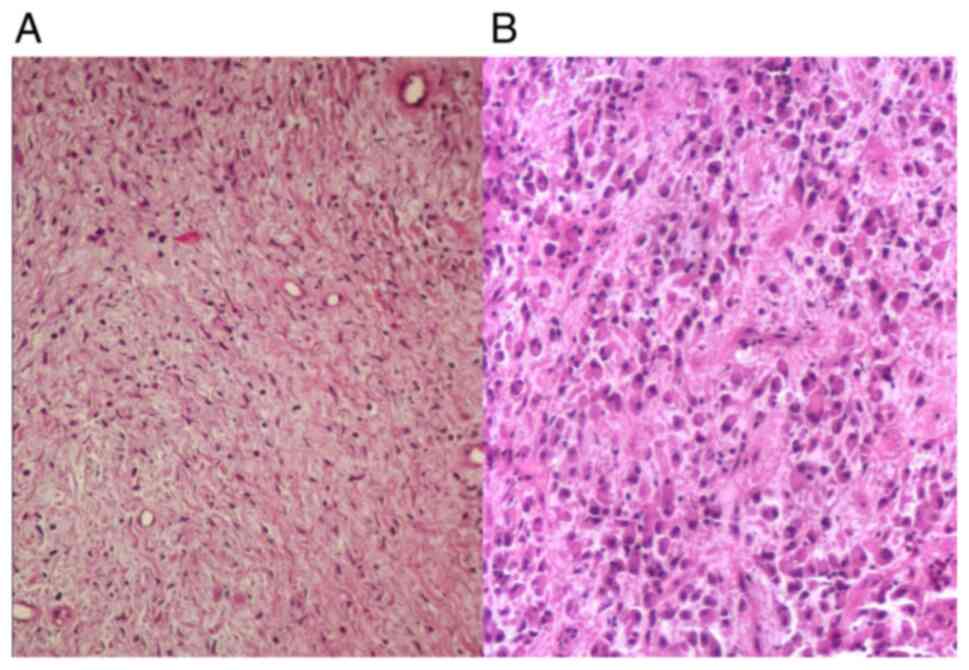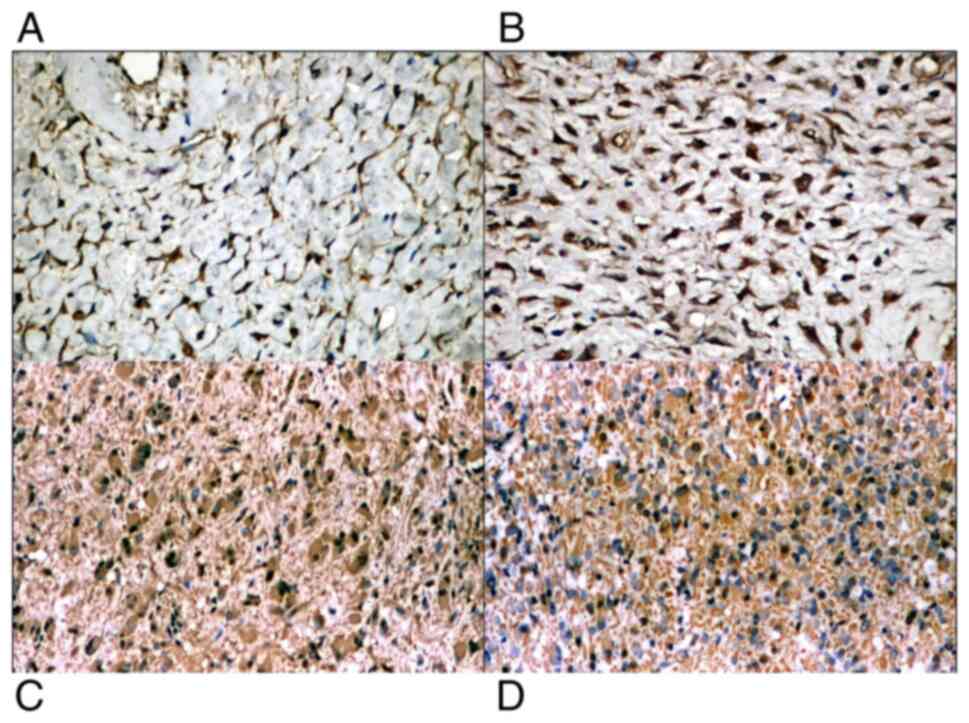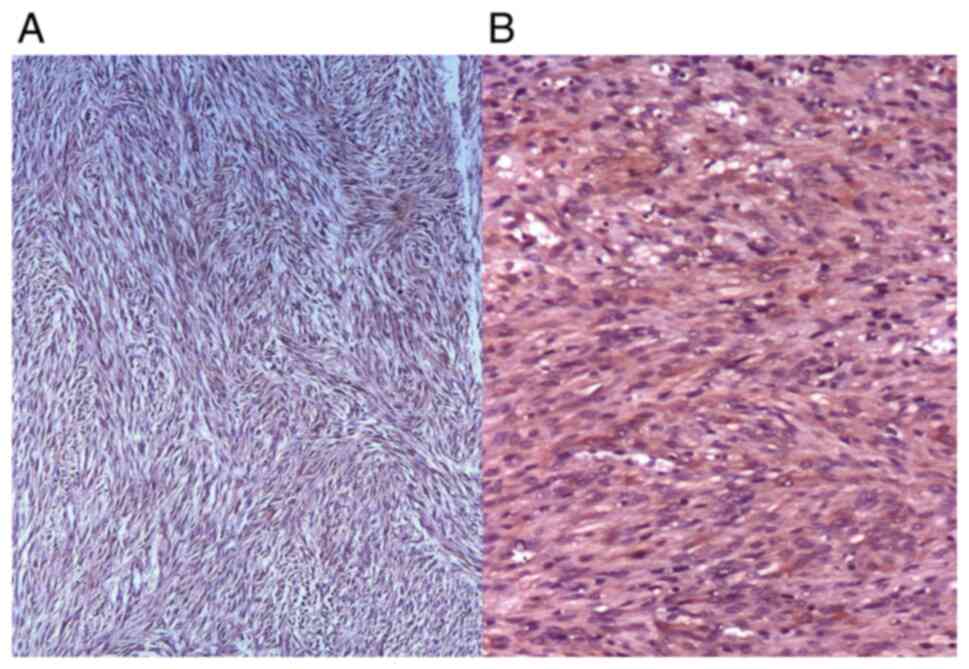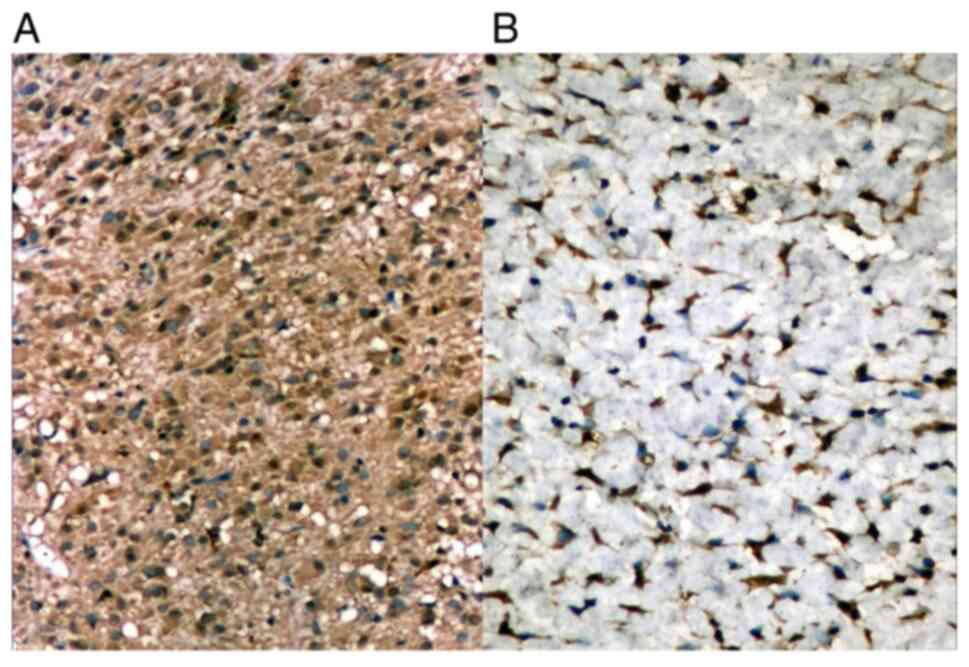|
1
|
Miettinen M and Lasota J: Gastrointestinal
stromal tumors: Review on morphology, molecular pathology,
prognosis, and differential diagnosis. Arch Pathol Lab Med.
130:1466–1478. 2006.PubMed/NCBI View Article : Google Scholar
|
|
2
|
Foo WC, Liegl-Atzwanger B and Lazar AJ:
Pathology of gastrointestinal stromal tumors. Clin Med Insights
Pathol. 5:23–33. 2012.PubMed/NCBI View Article : Google Scholar
|
|
3
|
Wada R, Arai H, Kure S, Peng WX and Naito
Z: ‘Wild type’ GIST: Clinicopathological features and clinical
practice. Pathol Int. 66:431–437. 2016.PubMed/NCBI View Article : Google Scholar
|
|
4
|
Miettinen M, Killian JK, Wang ZF, Lasota
J, Lau C, Jones L, Walker R, Pineda M, Zhu YJ, Kim SY, et al:
Immunohistochemical loss of succinate dehydrogenase subunit A
(SDHA) in gastrointestinal stromal tumors (GISTS) signals SDHA
germline mutation. The Am J Surg Pathol. 37:234–240.
2013.PubMed/NCBI View Article : Google Scholar
|
|
5
|
Gaal J, Stratakis CA, Carney JA, Ball ER,
Korpershoek E, Lodish MB, Levy I, Xekouki P, van Nederveen HF, den
Bakker MA, et al: SDHB immunohistochemistry: A useful tool in the
diagnosis of carney-stratakis and Carney triad gastrointestinal
stromal tumors. Mod Pathol. 24:147–151. 2011.PubMed/NCBI View Article : Google Scholar
|
|
6
|
Tirumani SH, Tirumani H, Jagannathan JP,
Shinagare AB, Hornick JL, George S, Wagner AJ and Ramaiya NH: MDCT
features of succinate dehydrogenase (SDH)-deficient
gastrointestinal stromal tumours. Br J Radiol.
87(20140476)2014.PubMed/NCBI View Article : Google Scholar
|
|
7
|
Reichardt P: The story of imatinib in
GIST-a journey through the development of a targeted therapy. Oncol
Res Treat. 41:472–477. 2018.PubMed/NCBI View Article : Google Scholar
|
|
8
|
Zhang X, Bai L, Wang D, Huang X, Wei J,
Zhang W, Zhang Z and Zhou J: Gastrointestinal stromal tumor risk
classification: Spectral CT quantitative parameters. Abdom Radiol
(NY). 44:2329–2336. 2019.PubMed/NCBI View Article : Google Scholar
|
|
9
|
Dei Tos AP, Hornick JL and Miettinen M:
Gastrointestinal stromal tumour. In: WHO Classification of Tumours:
Digestive system tumours. Fukayama M, Goldblum JR, Miettinen M and
Lazar AJ (eds). 5th edition. World Health Organization (WHO),
Geneva, pp439-443, 2019.
|
|
10
|
Cavaliere D, Griseri G, Venturino E,
Schirru A, Cosce U, Caristo I, Caliendo L, Pastorino A and
Cavaliere P: Management of patients with gastrointestinal stromal
tumors: Experience from an Italian group. Tumori. 91:467–471.
2005.PubMed/NCBI
|
|
11
|
Lin SC, Huang MJ, Zeng CY, Wang TI, Liu ZL
and Shiay RK: Clinical manifestations and prognostic factors in
patients with gastrointestinal stromal tumors. World J
Gastroenterol. 9:2809–2812. 2003.PubMed/NCBI View Article : Google Scholar
|
|
12
|
Korodi AD, Furau C, Furau G, Dimitriu M,
Socea B, Ada C, Botezatu D, Dumnici A, Totolici B, Barbu I, et al:
The types of tumoral vessels associated to GISTs are conditioning
the effectiveness of anti-vascular therapy with tyrosine kinase
receptor inhibitors. Rev Chim (Bucharest). 70:3250–3253. 2019.
|
|
13
|
Sorour MA, Kassem MI, Ghazal AE, El-Riwini
MT and Nasr AA: Gastrointestinal stromal tumors (GIST) related
emergencies. Int J Surg. 12:269–80. 2014.PubMed/NCBI View Article : Google Scholar
|
|
14
|
Constantin VD, Socea B, Popa F, Carâp AC,
Popescu G, Vlădescu T, Ceauşu Z, Bertesteanu SVG and Ceauşu MC: A
histopathological and immunohistochemical approach of surgical
emergencies of GIST. An interdisciplinary study. Rom J Morphol
Embryol. 55 (Suppl 2):S619–S627. 2014.PubMed/NCBI
|
|
15
|
Bouassida M, Chtourou MF, Chalbi E, Chebbi
F, Hamzaoui L, Sassi S, Charfi L, Mighri MM, Touinsi H and Sassi A:
Appendiceal GIST: Report of an exceptional case and review of the
literature. Pan Afr Med J. 15(85)2013.PubMed/NCBI View Article : Google Scholar
|
|
16
|
Ajduk M, Mikulić D, Sebecić B, Gasparov S,
Patrlj L, Erdelez L, Skopljanac A, Staresinić M, Desković S, Sosa T
and Sitić S: Spontaneously ruptured gastrointestinal stromal tumor
(GIST) of the jejunum mimicking acute appendicitis. Coll Antropol.
28:937–941. 2004.PubMed/NCBI
|
|
17
|
Giestas S, Almeida N, Martins R, Canhoto
A, Oliveira P, Figueiredo P and Sofia C: Small bowel GIST: Clinical
presentation as intussusception and obscure bleeding. GE Port J
Gastroenterol. 23:279–281. 2016.PubMed/NCBI View Article : Google Scholar
|
|
18
|
Miettinen M, Felisiak-Golabek A, Wang Z,
Inaguma S and Lasota J: GIST manifesting as a retroperitoneal
tumor: Clinicopathologic immunohistochemical, and molecular genetic
study of 112 cases. Am J Surg Pathol. 41:577–585. 2017.PubMed/NCBI View Article : Google Scholar
|
|
19
|
Bratu OG, Marcu RD, Socea B, Neagu TP,
Diaconu C, Scarneciu I, Turcu FL, Radavoi GD, Bratila E, Berceanu C
and Spinu AD: Immunohistochemistry particularities of
retroperitoneal tumors. Rev Chim (Bucharest). 69:1813–1816.
2018.
|
|
20
|
Sista F, Pessia B, Abruzzese V, Cecilia
EM, Schietroma M, Carlei F and Amicucci G: Twelve years of gastric
GIST. A retrospective study of laparoscopic and open approach. Ann
Ital Chir. 86:349–356. 2015.PubMed/NCBI
|
|
21
|
Park JH, Kang BK, Lee HL, Yoon JH, Lee KN,
Jun DW, Lee OY, Han DS, Yoon BC and Choi HS: Correlation between
three-dimensional volume and malignant potential of
gastrointestinal stromal tumors (GISTs). J Clin Med.
9(2763)2020.PubMed/NCBI View Article : Google Scholar
|
|
22
|
Parab TM, DeRogatis MJ, Boaz AM, Grasso
SA, Issack PS, Duarte DA, Urayeneza O, Vahdat S, Qiao JH and Hinika
GS: Gastrointestinal stromal tumors: A comprehensive review. J
Gastrointest Oncol. 10:144–154. 2019.PubMed/NCBI View Article : Google Scholar
|
|
23
|
Landi B: Gastrointestinal stromal tumors:
Clinical features and diagnosis. Bull Acad Natl Med. 196:845–852.
2012.PubMed/NCBI(In French).
|
|
24
|
von Mehren M and Joensuu H:
Gastrointestinal stromal tumors. J Clin Oncol. 36:136–143.
2018.PubMed/NCBI View Article : Google Scholar
|
|
25
|
Dimitrakopoulou-Strauss A, Ronellenfitsch
U, Cheng C, Pan L, Sachpekidis C, Hohenberger P and Henzler T:
Imaging therapy response of gastrointestinal stromal tumors (GIST)
with FDG PET, CT and MRI: A systematic review. Clin Transl Imaging.
5:183–197. 2017.PubMed/NCBI View Article : Google Scholar
|
|
26
|
Sanchez-Hidalgo JM, Duran-Martinez M,
Molero-Payan R, Rufian-Peña S, Arjona-Sanchez A, Casado-Adam A,
Cosano-Alvarez A and Briceño-Delgado J: Gastrointestinal stromal
tumors: A multidisciplinary challenge. World J Gastroenterol.
24:1925–1941. 2018.PubMed/NCBI View Article : Google Scholar
|
|
27
|
Lim KT and Tan KY: Current research and
treatment for gastrointestinal stromal tumors. World J
Gastroenterol. 23:4856–4866. 2017.PubMed/NCBI View Article : Google Scholar
|
|
28
|
Landi B, Blay JY, Bonvalot S, Brasseur M,
Coindre JM, Emile JF, Hautefeuille V, Honore C, Lartigau E, Mantion
G, et al: Gastrointestinal stromal tumours (GISTs): French
intergroup clinical practice guidelines for diagnosis, treatments
and follow-up (SNFGE, FFCD, GERCOR, UNICANCER, SFCD, SFED, SFRO).
Dig Liver Dis. 51:1223–1231. 2019.PubMed/NCBI View Article : Google Scholar
|
|
29
|
Agaimy A and Wünsch PH: Gastrointestinal
stromal tumours: A regular origin in the muscularis propria, but an
extremely diverse gross presentation. A review of 200 cases to
critically re-evaluate the concept of so-called
extra-gastrointestinal stromal tumours. Langenbecks Arch Surg.
391:322–329. 2006.PubMed/NCBI View Article : Google Scholar
|
|
30
|
Brcic I, Kashofer K, Skone D and
Liegl-Atzwanger B: KIT mutation in a naïve succinate dehydrogenase
deficient gastric GIST. Genes Chromosomes Cancer. 58:798–803.
2019.PubMed/NCBI View Article : Google Scholar
|
|
31
|
Gaopande VL, Joshi AR, Bhayekar PD and
Khandeparkar SG: Clinicopathologic and immunohistochemical study of
gastrointestinal stromal tumor (ten cases) and
extragastrointestinal stromal tumor (six cases) with review of
literature. J Curr Res Sci Med. 2:84–91. 2016.
|
|
32
|
Akahoshi K, Oya M, Koga T and Shiratsuchi
Y: Current clinical management of gastrointestinal stromal tumor.
World J Gastroenterol. 24:2806–2817. 2018.PubMed/NCBI View Article : Google Scholar
|
|
33
|
Hirota S: Differential diagnosis of
gastrointestinal stromal tumor by histopathology and
immunohistochemistry. Transl Gastroenterol Hepatol.
3(27)2018.PubMed/NCBI View Article : Google Scholar
|
|
34
|
Lai J, Kresak JL, Cao D, Zhang D, Zhang S,
Leon ME, Shenoy A, Liu W, Trevino J, Starostik P, et al: Gastric
plexiform fibromyxoma: A great mimic of gastrointestinal stromal
tumor (GIST) and diagnostic pitfalls. J Surg Res. 239:76–82.
2019.PubMed/NCBI View Article : Google Scholar
|
|
35
|
Alghamdi HM, Amr SS, Shawarby MA, Sheikh
SS, Alsayyah AA, Alamri AM, Ismail MH, Almarhabi A, Alrefaee MA and
Ahmed MI: Gastrointestinal stromal tumors, A clinicopathological
study. Saudi Med J. 40:126–130. 2019.PubMed/NCBI View Article : Google Scholar
|
|
36
|
Kang HC, Menias CO, Gaballah AH, Shroff S,
Taggart MW, Garg N and Elsayes KM: Beyond the GIST: Mesenchymal
tumors of the stomach. Radiographics. 33:1673–1690. 2013.PubMed/NCBI View Article : Google Scholar
|
|
37
|
Turner MS and Goldsmith JD: Best practices
in diagnostic immunohistochemistry: Spindle cell neoplasms of the
gastrointestinal tract. Arch Pathol Lab Med. 133:1370–1374.
2009.PubMed/NCBI View Article : Google Scholar
|
|
38
|
Penel N, Chibon F and Salas S: Adult
desmoid tumors: Biology, management and ongoing trials. Curr Opin
Oncol. 29:268–274. 2017.PubMed/NCBI View Article : Google Scholar
|
|
39
|
Lawrence B, Perez-Atayde A, Hibbard MK,
Rubin BP, Cin PD, Pinkus JL, Pinkus GS, Xiao S, Yi ES, Fletcher CD
and Fletcher JA: TPM3- ALK and TPM4-ALK oncogenes in inflammatory
myofibroblastic tumors. Am J Pathol. 157:377–384. 2000.PubMed/NCBI View Article : Google Scholar
|
|
40
|
Voltaggio L, Murray R, Lasota J and
Miettinen M: Gastric schwannoma: A clinicopathologic study of 51
cases and critical review of the literature. Hum Pathol.
43:650–659. 2012.PubMed/NCBI View Article : Google Scholar
|
|
41
|
Chmielecki J, Crago AM, Rosenberg M,
O'Connor R, Walker SR, Ambrogio L, Auclair D, McKenna A, Heinrich
MC, Frank DA and Meyerson M: Whole-exome sequencing identifies a
recurrent NAB2-STAT6 fusion in solitary fibrous tumors. Nat Genet.
45:131–132. 2013.PubMed/NCBI View Article : Google Scholar
|
|
42
|
Argani P, Aulmann S, Illei PB, Netto GJ,
Ro J, Cho HY, Dogan S, Landanyi M, Martignoni G, Goldblum JR and
Weiss SW: A distinctive subset of PE Comas harbors TFE3 gene
fusions. Am J Surg Pathol. 34:1395–1406. 2010.PubMed/NCBI View Article : Google Scholar
|
|
43
|
Joensuu H: Adjuvant treatment of GIST:
Patient selection and treatment strategies. Nat Rev Clin Oncol.
l9:351–358. 2012.PubMed/NCBI View Article : Google Scholar
|















